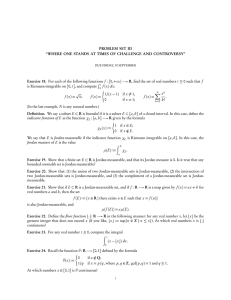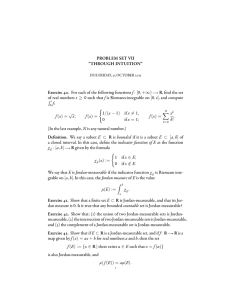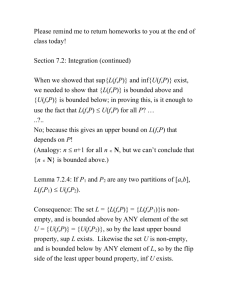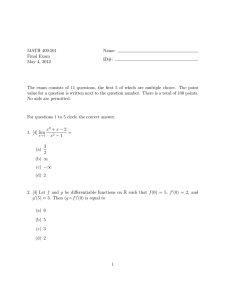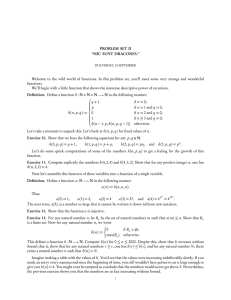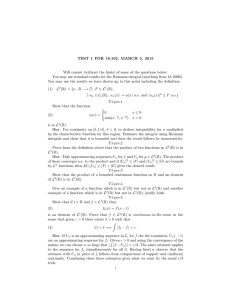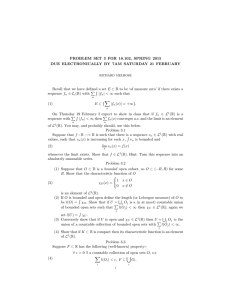MATH 409 Advanced Calculus I Lecture 19: Riemann sums.
advertisement
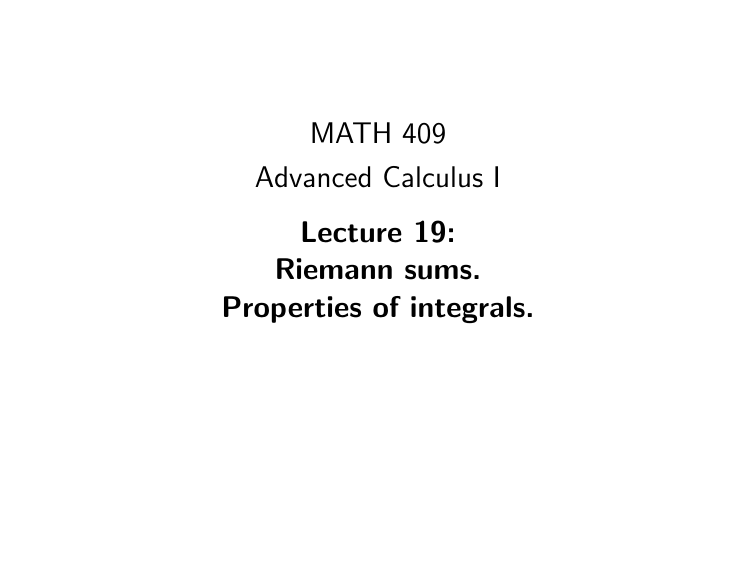
MATH 409
Advanced Calculus I
Lecture 19:
Riemann sums.
Properties of integrals.
Darboux sums
Let P = {x0 , x1, . . . , xn } be a partition of an interval [a, b],
where x0 = a < x1 < · · · < xn = b. Let f : [a, b] → R be a
bounded function.
Definition. The upper Darboux sum (or the upper
Riemann sum) of the function f over the partition P is the
number
n
X
U(f , P) =
Mj (f ) ∆j ,
j=1
where ∆j = xj − xj−1 and Mj (f ) = sup f ([xj−1 , xj ]) for
j = 1, 2, . . . , n. Likewise, the lower Darboux sum (or the
lower Riemann sum) of f over P is the number
n
X
mj (f ) ∆j ,
L(f , P) =
j=1
where mj (f ) = inf f ([xj−1 , xj ]) for j = 1, 2, . . . , n.
Upper and lower integrals
Suppose f : [a, b] → R is a bounded function.
Definition. The upper integral of f on [a, b], denoted
Z b
Z b
f (x) dx or (U)
f (x) dx, is the number
a
a
inf {U(f , P) | P is a partition of [a, b] }.
Similarly, the lower integral of f on [a, b], denoted
Z b
Z b
f (x) dx or (L)
f (x) dx, is the number
a
a
sup {L(f , P) | P is a partition of [a, b] }.
Remark. For any partitions P and Q of the interval [a, b],
Z b
Z b
L(f , P) ≤ (L)
f (x) dx ≤ (U)
f (x) dx ≤ U(f , Q).
a
a
Integrability
Definition. A bounded function f : [a, b] → R is
called integrable (or Riemann integrable) on the
interval [a, b] if the upper and lower integrals of f
on [a, b] coincide. The common value is called the
integral of f on [a, b] (or over [a, b]).
Theorem A bounded function f : [a, b] → R is
integrable on [a, b] if and only if for every ε > 0
there is a partition Pε of [a, b] such that
U(f , Pε ) − L(f , Pε ) < ε.
Theorem If a function is continuous on the
interval [a, b], then it is integrable on [a, b].
Riemann sums
Definition. A Riemann sum of a function f : [a, b] → R
with respect to a partition P = {x0 , x1, . . . , xn } of [a, b]
generated by samples tj ∈ [xj−1 , xj ] is a sum
Xn
S(f , P, tj ) =
f (tj ) (xj − xj−1 ).
j=1
Remark. Note that the function f need not be bounded. If f
is bounded, then L(f , P) ≤ S(f , P, tj ) ≤ U(f , P) for any
choice of samples tj .
Definition. The Riemann sums S(f , P, tj ) converge to a limit
I (f ) as the norm kPk → 0 if for every ε > 0 there exists
δ > 0 such that kPk < δ implies |S(f , P, tj ) − I (f )| < ε for
any partition P and choice of samples tj .
Theorem The Riemann sums S(f , P, tj ) converge to a limit
I (f ) as kPk → 0 if and only if the function f is integrable on
Rb
[a, b] and I (f ) = a f (x) dx.
Darboux sums and a Riemann sum
x0
x1
x2
x3
x4
x0 t1
x1 t2
x2 t3 x3 t4 x4
Proof of the theorem (“only if”): Assume that the Riemann
sums S(f , P, tj ) converge to a limit I (f ) as kPk → 0. Given
ε > 0, we choose δ > 0 so that for every partition P with
kPk < δ, we have |S(f , P, tj ) − I (f )| < ε for any choice of
samples tj . Let t̃j be a different set of samples for the same
partition P. Then |S(f , P, t̃j ) − I (f )| < ε. We can choose
the samples tj , t̃j so that f (tj ) is arbitrarily close to
sup f ([xj−1 , xj ]) while f (t̃j ) is arbitrarily close to
inf f ([xj−1 , xj ]). That way S(f , P, tj ) gets arbitrarily close to
U(f , P) while S(f , P, t̃j ) gets arbitrarily close to L(f , P).
Hence it follows from the above inequalities that
|U(f , P) − I (f )| ≤ ε and |L(f , P) − I (f )| ≤ ε. As a
consequence, U(f , P) − L(f , P) ≤ 2ε. In particular, the
function f is bounded. We conclude that f is integrable.
Rb
Let I = a f (x) dx. The number I lies between L(f , P) and
U(f , P). The inequalities U(f , P) − L(f , P) ≤ 2ε and
|U(f , P) − I (f )| ≤ ε imply that |I − I (f )| ≤ 3ε. As ε can be
arbitrarily small, I = I (f ).
Integration as a linear operation
Theorem 1 If functions f , g are integrable on an
interval [a, b], then the sum f + g is also
integrable on [a, b] and
Z b
Z b
Z b
g (x) dx.
f (x) dx +
f (x) + g (x) dx =
a
a
a
Theorem 2 If a function f is integrable on [a, b],
then for each α ∈ R the scalar multiple αf is also
integrable on [a, b] and
Z b
Z b
αf (x) dx = α
f (x) dx.
a
a
Proof of Theorems 1 and 2: Let I (f ) denote the integral of f
and I (g ) denote the integral of g over [a, b]. The key
observation is that the Riemann sums depend linearly on a
function. Namely, S(f + g , P, tj ) = S(f , P, tj ) + S(g , P, tj )
and S(αf , P, tj ) = α · S(f , P, tj ) for any partition P of [a, b]
and choice of samples tj . It follows that
|S(f + g , P, tj ) − I (f ) − I (g )|
≤ |S(f , P, tj ) − I (f )| + |S(g , P, tj ) − I (g )|,
|S(αf , P, tj ) − αI (f )| = |α| · |S(f , P, tj ) − I (f )|.
As kPk → 0, the Riemann sums S(f , P, tj ) and S(g , P, tj )
get arbirarily close to I (f ) and I (g ), respectively. Then
S(f + g , P, tj ) will be getting arbitrarily close to I (f ) + I (g )
while S(αf , P, tj ) will be getting arbitrarily close to αI (f ).
Thus I (f ) + I (g ) is the integral of f + g and αI (f ) is the
integral of αf over [a, b].
Theorem If a function f is integrable on [a, b],
then it is integrable on each subinterval
[c, d ] ⊂ [a, b].
Proof: Since f is integrable on the interval [a, b], for any
ε > 0 there is a partition Pε of [a, b] such that
U(f , Pε ) − L(f , Pε ) < ε. Given a subinterval [c, d ] ⊂ [a, b],
let Pε0 = Pε ∪ {c, d } and Qε = Pε0 ∩ [c, d ]. Then Pε0 is a
partition of [a, b] that refines Pε . Hence
U(f , Pε0 ) − L(f , Pε0 ) ≤ U(f , Pε ) − L(f , Pε ) < ε.
Since Qε is a partition of [c, d ] contained in Pε0 , it follows that
U(f , Qε ) − L(f , Qε ) ≤ U(f , Pε0 ) − L(f , Pε0 ) < ε.
We conclude that f is integrable on [c, d ].
Theorem If a function f is integrable on [a, b]
then for any c ∈ (a, b),
Z b
Z c
Z b
f (x) dx =
f (x) dx +
f (x) dx.
a
a
c
Proof: Since f is integrable on the interval [a, b], it is also
integrable on subintervals [a, c] and [c, b]. Let P be a
partition of [a, c] and {tj } be some samples for that partition.
Further, let Q be a partition of [c, b] and {τi } be some
samples for that partition. Then P ∪ Q is a partition of [a, b]
and {tj } ∪ {τi } are samples for it. The key observation is that
S(f , P ∪ Q, {tj } ∪ {τi }) = S(f , P, tj ) + S(f , Q, τi ).
If kPk → 0 and kQk → 0, then kP ∪ Qk = max(kPk, kQk)
tends to 0 as well. Therefore the Riemann
latter
R b sums inR the
c
equality will converge to the integrals a f (x) dx, a f (x) dx,
Rb
and c f (x) dx, respectively.
Theorem If a function f is integrable on [a, b]
and f ([a, b]) ⊂ [A, B], then for each continuous
function g : [A, B] → R the composition g ◦ f is
also integrable on [a, b].
Corollary If functions f and g are integrable on
[a, b], then so is fg .
Proof: We have (f + g )2 = f 2 + g 2 + 2fg . Since f and g
are integrable on [a, b], so is f + g . Since h(x) = x 2 is a
continuous function on R, the compositions h ◦ f = f 2 ,
h ◦ g = g 2 , and h ◦ (f + g ) = (f + g )2 are integrable on
[a, b]. Then fg = 21 (f + g )2 − 21 f 2 − 12 g 2 is integrable on
[a, b] as a linear combination of integrable functions.
Comparison Theorem for integrals
Theorem If functions f , g are integrable on [a, b]
and f (x) ≤ g (x) for all x ∈ [a, b], then
Z b
Z b
f (x) dx ≤
g (x) dx.
a
a
Proof: Since f ≤ g on the interval [a, b], it follows that
S(f , P, tj ) ≤ S(g , P, tj ) for any partition P of [a, b] and
choice of samples tj . As kPk → 0, the sum S(f , P, tj ) gets
arbitrarily close to the integral of f while S(g , P, tj ) gets
arbitrarily close to the integral of g . The theorem follows.
Corollary 1 If f is integrable on [a, b] and
Z b
f (x) ≥ 0 for x ∈ [a, b], then
f (x) dx ≥ 0.
a
Corollary 2 If f is integrable on [a, b] and
m ≤ f (x) ≤ M for x ∈ [a, b], then
Z b
m(b − a) ≤
f (x) dx ≤ M(b − a).
a
Corollary 3 If f is integrable on [a, b], then the
function |f | is also integrable on [a, b] and
Z b
Z b
|f (x)| dx.
f (x) dx ≤
a
a
Proof: The function |f | is the composition of f with a
continuous function g (x) = |x|. Therefore |f | is integrable on
[a, b]. Since −|f (x)| ≤ f (x) ≤ |f (x)| for x ∈ [a, b], the
Comparison Theorem for integrals implies that
Z b
Z b
Z b
−
|f (x)| dx ≤
f (x) dx ≤
|f (x)| dx.
a
a
a
Integral with variable limit
Suppose f : [a, b] → RZ is an integrable function. For any
x
x ∈ [a, b] let F (x) =
f (t) dt (we assume that F (a) = 0).
a
Theorem The function F is well defined and continuous on
[a, b].
Proof: Since the function f is integrable on [a, b], it is also
integrable on each subinterval of [a, b]. Hence the function F
is well defined on [a, b]. Besides, f is bounded: |f (t)| ≤ M
for some M > 0 Rand all t ∈ [a,
R xb]. For anyR yx, y ∈ [a, b],
y
x ≤ y , we have a f (t) dt = a f (t) dt + x f (t) dt. It
follows that
Z
Z
y
y
f (t) dt ≤
|F (y ) − F (x)| =
x
|f (t)| dt ≤ M |y − x|.
x
Thus F is a Lipschitz function on [a, b], which implies that F
is uniformly continuous on [a, b].
Sets of measure zero
Definition. A subset E of the real line R is said to have
measure zero if for any ε > 0 the set E can be covered by
countably
many open intervals J1 , J2 , . . . such that
P∞
|J
|
<
ε.
n=1 n
Examples. • Any countable set has measure zero.
Indeed, suppose E is a countable set and let x1 , x2 , . . . be a
list of all elements of E . Given ε > 0, let
ε
ε Jn = xn − n+1 , xn + n+1 , n = 1, 2, . . .
2
2
Then P
E ⊂ J1 ∪ J2 ∪ . . . and |Jn | = ε/2n for all n ∈ N so
∞
that
n=1 |Jn | = ε.
• A nondegenerate interval [a, b] is not a set of measure
zero.
• There exist sets of measure zero that are of the same
cardinality as R.
Lebesgue’s criterion for Riemann integrability
Definition. Suppose P(x) is a property depending
on x ∈ S, where S ⊂ R. We say that P(x) holds
for almost all x ∈ S (or almost everywhere on
S) if the set {x ∈ S | P(x) does not hold } has
measure zero.
Theorem A function f : [a, b] → R is Riemann
integrable on the interval [a, b] if and only if f is
bounded on [a, b] and continuous almost
everywhere on [a, b].


